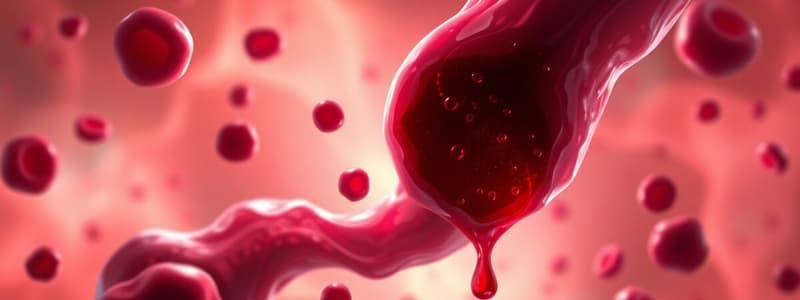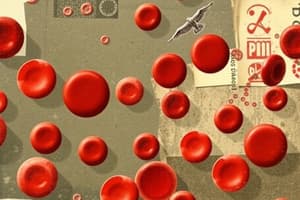Podcast
Questions and Answers
What are the three main processes included under the umbrella term 'hematopoiesis'?
What are the three main processes included under the umbrella term 'hematopoiesis'?
Erythropoiesis (red blood cells), leucopoiesis (white blood cells), and megakaryopoiesis (platelets).
Briefly outline the three key events that occur during erythropoiesis.
Briefly outline the three key events that occur during erythropoiesis.
Gradual decrease in cell size, condensation and eventual expulsion of the nucleus, and increase in hemoglobin production.
How do hemoglobin concentration, red blood cells (RBCs), and hematocrit values relate to the definition of anemia?
How do hemoglobin concentration, red blood cells (RBCs), and hematocrit values relate to the definition of anemia?
Anemia is defined by a reduction in hemoglobin concentration, RBCs, and hematocrit values below normal for age and sex.
List at least three potential causes of anemia related to decreased RBC production.
List at least three potential causes of anemia related to decreased RBC production.
Differentiate between microcytic, normocytic, and macrocytic anemia based on mean corpuscular volume (MCV) values.
Differentiate between microcytic, normocytic, and macrocytic anemia based on mean corpuscular volume (MCV) values.
Name at least two causes of normocytic anemia.
Name at least two causes of normocytic anemia.
What two vitamin deficiencies typically result in a Megaloblastic anemia?
What two vitamin deficiencies typically result in a Megaloblastic anemia?
How can the reticulocyte count help in assessing anemia?
How can the reticulocyte count help in assessing anemia?
What clinical manifestations are a direct result of diminished oxygen supply to the tissues?
What clinical manifestations are a direct result of diminished oxygen supply to the tissues?
List three general symptoms associated with anemia.
List three general symptoms associated with anemia.
When assessing a patient for anemia, where should you look for pallor?
When assessing a patient for anemia, where should you look for pallor?
Which specific signs suggest iron deficiency anemia (IDA)?
Which specific signs suggest iron deficiency anemia (IDA)?
What is the primary feature of anemia characterized by laboratory investigations of red blood cells?
What is the primary feature of anemia characterized by laboratory investigations of red blood cells?
In a patient with anemia, what does pancytopenia suggest?
In a patient with anemia, what does pancytopenia suggest?
Describe the typical iron profile findings in microcytic anemia, like iron deficiency anemia (IDA).
Describe the typical iron profile findings in microcytic anemia, like iron deficiency anemia (IDA).
In the context of hemolytic anemia, what test is performed in the lab?
In the context of hemolytic anemia, what test is performed in the lab?
List some important causes of microcytic hypochromic anemia.
List some important causes of microcytic hypochromic anemia.
In what part of the body is iron absorbed?
In what part of the body is iron absorbed?
List three or more etiologies of IDA.
List three or more etiologies of IDA.
List clinical findings that might suggest a diagnosis of Iron Deficiency Anemia
List clinical findings that might suggest a diagnosis of Iron Deficiency Anemia
If a patient has Iron Deficiency Anemia (IDA), what test should be performed?
If a patient has Iron Deficiency Anemia (IDA), what test should be performed?
What are the 5 means of treating IDA?
What are the 5 means of treating IDA?
What ingredients should be in an iron-rich diet?
What ingredients should be in an iron-rich diet?
List a possible etiology for refractory IDA.
List a possible etiology for refractory IDA.
Give the definition for Erythropoiesis.
Give the definition for Erythropoiesis.
Give the definition for Mean Corpuscular Volume, or MCV.
Give the definition for Mean Corpuscular Volume, or MCV.
Give the definition for Mean Corpuscular Hemoglobin or MCH.
Give the definition for Mean Corpuscular Hemoglobin or MCH.
Describe the difference between Acute vs Chronic cases of Hemorrhage related to Regenerative vs Non-Regenerative RBC production.
Describe the difference between Acute vs Chronic cases of Hemorrhage related to Regenerative vs Non-Regenerative RBC production.
In reference to other causes of pallor other than anemia, what do MI and Myxedema stand for?
In reference to other causes of pallor other than anemia, what do MI and Myxedema stand for?
What is the normal range for Reticulocytes' count?
What is the normal range for Reticulocytes' count?
Explain the significance of reticulocyte count in differentiating between hyporegenerative and regenerative anemia.
Explain the significance of reticulocyte count in differentiating between hyporegenerative and regenerative anemia.
Describe the underlying mechanisms that lead to the development of koilonychia and angular stomatitis in individuals with iron deficiency anemia (IDA).
Describe the underlying mechanisms that lead to the development of koilonychia and angular stomatitis in individuals with iron deficiency anemia (IDA).
How does the bone marrow respond differently in hemolytic anemia compared to aplastic anemia, and how is this reflected in laboratory findings?
How does the bone marrow respond differently in hemolytic anemia compared to aplastic anemia, and how is this reflected in laboratory findings?
Explain the rationale behind using hemoglobin electrophoresis in the diagnosis of certain types of anemia, and what specific information does it provide?
Explain the rationale behind using hemoglobin electrophoresis in the diagnosis of certain types of anemia, and what specific information does it provide?
In the context of a microcytic anemia diagnostic workup, what is the utility of assessing both serum iron and total iron-binding capacity (TIBC), and how do their values help differentiate between iron deficiency anemia and anemia of chronic disease?
In the context of a microcytic anemia diagnostic workup, what is the utility of assessing both serum iron and total iron-binding capacity (TIBC), and how do their values help differentiate between iron deficiency anemia and anemia of chronic disease?
Describe the pathophysiology behind the development of neurological symptoms, such as paresthesia, in vitamin B12 deficiency, and how it differs from the pathophysiology of anemia in the same condition.
Describe the pathophysiology behind the development of neurological symptoms, such as paresthesia, in vitamin B12 deficiency, and how it differs from the pathophysiology of anemia in the same condition.
Explain why iron is absorbed in the duodenum, relating it to physiological conditions in that specific part of the gastrointestinal tract.
Explain why iron is absorbed in the duodenum, relating it to physiological conditions in that specific part of the gastrointestinal tract.
Describe the rationale for using parenteral iron in patients with chronic kidney disease undergoing erythropoiesis-stimulating agent (ESA) therapy.
Describe the rationale for using parenteral iron in patients with chronic kidney disease undergoing erythropoiesis-stimulating agent (ESA) therapy.
Explain the significance of increased red cell distribution width (RDW) in the context of iron deficiency anemia and how it differs from thalassemia.
Explain the significance of increased red cell distribution width (RDW) in the context of iron deficiency anemia and how it differs from thalassemia.
Describe the role of hepcidin in the pathophysiology of anemia of chronic disease (ACD) and how it contributes to iron-restricted erythropoiesis.
Describe the role of hepcidin in the pathophysiology of anemia of chronic disease (ACD) and how it contributes to iron-restricted erythropoiesis.
Explain how chronic blood loss, such as heavy menstrual bleeding, can lead to iron deficiency anemia over time.
Explain how chronic blood loss, such as heavy menstrual bleeding, can lead to iron deficiency anemia over time.
Describe osmotic fragility test and its use in diagnosing specific types of hemolytic anemia.
Describe osmotic fragility test and its use in diagnosing specific types of hemolytic anemia.
What is the rationale behind performing a bone marrow examination in the diagnostic workup of anemia, and what specific information does it provide that cannot be obtained through peripheral blood analysis?
What is the rationale behind performing a bone marrow examination in the diagnostic workup of anemia, and what specific information does it provide that cannot be obtained through peripheral blood analysis?
Briefly describe the pathogenesis of anemia in thalassemia syndromes, including the roles of alpha and beta globin chain imbalances.
Briefly describe the pathogenesis of anemia in thalassemia syndromes, including the roles of alpha and beta globin chain imbalances.
How does lead poisoning induce sideroblastic anemia, and what specific enzymatic pathways are disrupted by lead?
How does lead poisoning induce sideroblastic anemia, and what specific enzymatic pathways are disrupted by lead?
Explain the difference between hereditary spherocytosis and autoimmune hemolytic anemia in terms of their underlying mechanisms and diagnostic tests.
Explain the difference between hereditary spherocytosis and autoimmune hemolytic anemia in terms of their underlying mechanisms and diagnostic tests.
Describe the typical peripheral blood smear findings in megaloblastic anemia caused by vitamin B12 or folate deficiency.
Describe the typical peripheral blood smear findings in megaloblastic anemia caused by vitamin B12 or folate deficiency.
How does anemia of liver disease develop, and what are the main mechanisms contributing to its pathogenesis?
How does anemia of liver disease develop, and what are the main mechanisms contributing to its pathogenesis?
Describe the role and limitations of using mean corpuscular volume (MCV) in the initial evaluation of anemia.
Describe the role and limitations of using mean corpuscular volume (MCV) in the initial evaluation of anemia.
What etiological factors should be considered in patients diagnosed with macrocytic anemia but without megaloblastic changes in the bone marrow?
What etiological factors should be considered in patients diagnosed with macrocytic anemia but without megaloblastic changes in the bone marrow?
Describe the mechanism by which hemolysis leads to jaundice, and differentiate between pre-hepatic, hepatic, and post-hepatic causes of jaundice.
Describe the mechanism by which hemolysis leads to jaundice, and differentiate between pre-hepatic, hepatic, and post-hepatic causes of jaundice.
Explain the expected changes in the iron profile (serum iron, ferritin, TIBC) in a patient with sideroblastic anemia.
Explain the expected changes in the iron profile (serum iron, ferritin, TIBC) in a patient with sideroblastic anemia.
Describe the role played by erythropoietin in the regulation of erythropoiesis, mentioning the triggers for its release, and the cells responsible for its production.
Describe the role played by erythropoietin in the regulation of erythropoiesis, mentioning the triggers for its release, and the cells responsible for its production.
Apart from iron supplementation, what additional management strategies would be recommended for a patient with iron deficiency anemia secondary to Helicobacter pylori infection?
Apart from iron supplementation, what additional management strategies would be recommended for a patient with iron deficiency anemia secondary to Helicobacter pylori infection?
Explain the significance of elevated levels of lactate dehydrogenase (LDH) and indirect bilirubin in the context of suspected hemolytic anemia.
Explain the significance of elevated levels of lactate dehydrogenase (LDH) and indirect bilirubin in the context of suspected hemolytic anemia.
What are the key differences in bone marrow morphology between a patient with aplastic anemia and one with myelodysplastic syndrome (MDS)?
What are the key differences in bone marrow morphology between a patient with aplastic anemia and one with myelodysplastic syndrome (MDS)?
How is the direct Coombs test used to diagnose autoimmune hemolytic anemia, and what does a positive result indicate?
How is the direct Coombs test used to diagnose autoimmune hemolytic anemia, and what does a positive result indicate?
Describe the underlying genetic mutations associated with hereditary spherocytosis, and explain how these mutations lead to the characteristic shape and increased fragility of red blood cells.
Describe the underlying genetic mutations associated with hereditary spherocytosis, and explain how these mutations lead to the characteristic shape and increased fragility of red blood cells.
Describe the pathophysiology behind the development of 'beefy red tongue' in patients with vitamin B12 deficiency.
Describe the pathophysiology behind the development of 'beefy red tongue' in patients with vitamin B12 deficiency.
Explain the diagnostic approach for iron-refractory iron deficiency anemia (IRIDA).
Explain the diagnostic approach for iron-refractory iron deficiency anemia (IRIDA).
Flashcards
Hematopoiesis
Hematopoiesis
The process of blood cell formation.
Erythropoiesis
Erythropoiesis
Formation of red blood cells.
Leucopoiesis
Leucopoiesis
Formation of white blood cells.
Megakaryopoiesis
Megakaryopoiesis
Signup and view all the flashcards
Erythropoiesis Definition
Erythropoiesis Definition
Signup and view all the flashcards
RBC Size
RBC Size
Signup and view all the flashcards
RBC Nucleus Disappearance
RBC Nucleus Disappearance
Signup and view all the flashcards
Hemoglobin Build Up
Hemoglobin Build Up
Signup and view all the flashcards
Anemia Definition
Anemia Definition
Signup and view all the flashcards
Anemia Due to Reduced RBC Creation
Anemia Due to Reduced RBC Creation
Signup and view all the flashcards
Anemia Due to Bone Marrow Infiltration
Anemia Due to Bone Marrow Infiltration
Signup and view all the flashcards
Anemia Due to missing Ingredients
Anemia Due to missing Ingredients
Signup and view all the flashcards
Anemia Due to Blood Loss
Anemia Due to Blood Loss
Signup and view all the flashcards
Anemia Due to Chronic Disease
Anemia Due to Chronic Disease
Signup and view all the flashcards
Anemia Due to Endocrine Imbalance
Anemia Due to Endocrine Imbalance
Signup and view all the flashcards
Anemia Due to Kidney Issue
Anemia Due to Kidney Issue
Signup and view all the flashcards
Microcytic Anemia
Microcytic Anemia
Signup and view all the flashcards
Normocytic Anemia
Normocytic Anemia
Signup and view all the flashcards
Macrocytic Anemia
Macrocytic Anemia
Signup and view all the flashcards
MCH Decrease
MCH Decrease
Signup and view all the flashcards
MCHC Decrease
MCHC Decrease
Signup and view all the flashcards
Normal RBC Level
Normal RBC Level
Signup and view all the flashcards
IDA Incidence
IDA Incidence
Signup and view all the flashcards
Anemia Symptoms
Anemia Symptoms
Signup and view all the flashcards
Koilonychia
Koilonychia
Signup and view all the flashcards
Treatments for IDA
Treatments for IDA
Signup and view all the flashcards
Iron-Rich Foods
Iron-Rich Foods
Signup and view all the flashcards
Iron Supplementation
Iron Supplementation
Signup and view all the flashcards
Ferrous sulfate
Ferrous sulfate
Signup and view all the flashcards
Reticulocyte Count Use
Reticulocyte Count Use
Signup and view all the flashcards
Microcytic Anemia Cause
Microcytic Anemia Cause
Signup and view all the flashcards
IDA Iron Studies
IDA Iron Studies
Signup and view all the flashcards
Parenteral Iron Use
Parenteral Iron Use
Signup and view all the flashcards
Chronic Disorders Anemia
Chronic Disorders Anemia
Signup and view all the flashcards
Study Notes
Hematology
- Hematology covers erythropoiesis and anemia.
Hematopoiesis
- The process of blood cell formation.
- Erythropoiesis is the formation of red blood cells.
- Leucopoiesis is the formation of white blood cells.
- Megakaryopoiesis is the formation of platelets.
Erythropoiesis
- New red blood cells formation
- Involves a gradual decrease in cell size
- Causes condensation and eventual expulsion of the nucleus
- Leads to increase in hemoglobin production
Normal Adult Red Cell Values
- Hemoglobin for adult males is 14-16 g/dl
- Hemoglobin for adult females is 13-15 g/dl
- PCV/HCT for adult males is 40-52%
- PCV/HCT for adult females is 36-48%
- Red cell count for adult males is 4.5-6.5 x10^12/l
- Red cell count for adult females is 3.9-5.6 x10^12/l
- Mean corpuscular volume is 80-95 fL
- Mean corpuscular hemoglobin 27-34 pg
- MCHC 30-35 g/dL
- Reticulocyte count of 50-150 x10^9/L
Anemia
- Reduction in hemoglobin concentration
- Reduction in red blood cells and hematocrit values below normal for age and sex
- Hemoglobin for adult males is less than 130 g/L
- Hemoglobin for adult females is less than 120 g/L
- Anemia is a sign of a disease process rather than a disease
Etiological Classification of Anemia
- Decreased Bone Marrow function may cause aplastic anemia.
- Bone marrow infiltration may cause leukemia or lymphoma.
- Deficiency in substances essential for hematopoiesis causes deficiency anemia
- Iron deficiency anemia
- Megaloblastic anemia is due to vitamin B12 and folic acid deficiency.
- Excessive red blood cell loss causes Hemorrhagic anemia or Hemolytic anemia.
- Chronic disorders cause anemia.
- Endocrinal disorders cause anemia.
- Renal failure cause anemia.
- Liver disease anemia.
- The reticulocyte count assesses red blood cell regeneration, hyporegenerative Regenerative anemia helps to identify.
Morphological Classification of Anemia
- Microcytic anemia has a decreased MCV of less than 80 fL
- Microcytic anemia has aMCH of less than 27 pg
- Microcytic anemia has a MCHC of less than 30 g/dl
- Microcytic anemia includes iron deficiency anemia, thalassemia, lead poisoning, sideroblastic anemia, and anemia of chronic disease.
- Macrocytic anemia has MCV higher than 95-100 fL
- Macrocytic anemia is megaloblastic when caused by Vitamin B12 or folic acid deficiency
- Macrocytic anemia is non-megaloblastic when caused by alcohol, pregnancy, liver diseases, smoking, and reticulocytosis.
- Mean Corpuscular Volume (MCV) is the size of red blood cells.
- Mean Corpuscular Hemoglobin (MCH) is the hemoglobin concentration inside red blood cells.
BM Proliferative Response
- Hypo-proliferative anemia (aregenerative) are due to Bone Marrow failure/Aplastic anemia, Myelodysplasia, Anemia of chronic disease, and Megaloblastic anemia.
- Hyperproliferative is regenerative and is due to Hemorrhage, or Hemolysis.
- Reflected by Reticulocytes' count (RC) = (Normal = 0.5-2.5%)
Clinical Manifestations of Anemia
- Reflects diminished oxygen supply to the tissues.
- Depends on speed of onset, severity of anemia, age of patient, and underlying diseases, especially cardiovascular diseases
Anemia Symptoms
- Lack of concentration, headache, tinnitus, and blurring of vision.
- Low COP symptoms, exertional dyspnea and palpitation, angina and intermittent claudication, and symptoms of heart failure
- Bone ache, and fatigability.
- Menstrual disturbance and decreased libido.
- Polyuria.
Anemia Signs
- Detected in palm and palmer creases, nail bed, tongue and inner conjunctiva
- Pallor may also arise from infective endocarditis, MI, and myxedema.
- Tachycardia, hemic murmur, collapsing pulse, capillary pulsation, and congestive heart failure.
- Increased capillary permeability, and HF.
- Koilonychia (spoon nails) and angular stomatitis indicate IDA.
- Jaundice indicates hemolytic and megaloblastic anemias.
- Bone deformity and mongoloid facies indicate thalassemia.
- Leg ulcer indicates sickle cell anemia.
- Purpura and infection suggests decreased Bone Marrow
- Beefy red tongue may indicate megaloblastic anemia
- Pain and paresthesia indicates B12 deficiency.
Laboratory Investigations
- Red blood cells are normocytic, microcytic, or macrocytic.
- Decreased White blood cells and platelets in pancytopenia.
- Pancytopenia indicates aplastic anemia, hypersplenism, myelofibrosis, a leukemic leukemia, BM infiltration, megaloblastic anemia, PNH, or SLE.
- Bone marrow exam tests for Bone Marrow Failure, leukemia, and infiltration.
- Increased Reticulocyte Count indicates Hemolytic anemia or Hemorrhagic anemia.
- Decreased Reticulocyte Count indicates Bone marrow Failure or infiltration.
Microcytic Anemia Investigations
- Check serum iron, serum ferritin and TIBC.
- Perform Hemoglobin Electrophoresis.
- In IDA, serum iron and serum ferritin are decreased, while TIBC is increased
- In Anemia of chronic disease, serum iron is decreased, serum ferritin may be normal or increased, and TIBC is decreased
- In Thalassemia, serum iron, serum ferritin and TIBC are all normal
- In Sideroblastic Anemia, serum iron and serum ferritin are increased, while TIBC is normal
Normocytic Anemia Investigations
- Increased Reticulocytes indicates hemolytic & hemorrhagic
- Decreased Reticulocytes indicates Bone Marrow failure
- Decreased cellularity and Increased fatty spaces in Aplastic Anemia
- Serum bilirubin, urine urobilinogen, and fecal stercobilinogen are increased; serum haptaglobin is decreased and reticulocytosis, and Bone Marrow Analysis erythroid hyperplasia are present
Hemolytic Anemia Investigations
- Perform a Hemoglobin electrophoresis to test for hemoglobinopathies.
- Perform a sickling test to test for sickle anemia.
- Test with osmotic fragility for spherocytosis.
- Enzyme assay for GP6D
- Direct coomb's test for autoimmune hemolytic anemia
- Ham’s test and flow cytometry → PNH (hemolysis of RBCs at low pH serum).
- For Macrocytic Anemia serum Folate and B12 level should be checked.
Microcytic Hypochromic Anemia
- Most common cause of anemia
- Most important cause of microcytic hypochromic anemia.
- Majority affected are young children, adolescent girls, and women.
- Iron is absorbed in the duodenum.
Etiology of IDA Include
- Low iron diet, such as in young children and those with restricted diets (vegetarian, vegan)
- Chronic External blood loss, such as menstrual blood loss in post-menarchal adolescents and gastrointestinal blood loss in adolescent and adult males.
- Blood donation.
- Malabsorption, such as Gastrointestinal conditions (Crohn’s disease, tropical sprue and celiac disease) in recurrent, refractory, persistent cases, or Iron refractory iron deficiency anemia (IRIDA).
Clinical Presentation of IDA Include
- General symptoms & signs of anemia, painless glossitis, angular stomatitis, and pica
- Brittle, ridge or spoon nails (koilonychia) and dysphagia as a result of pharyngeal webs (Paterson-Kelly or Plummer-Vinson syndrome).
- Koilonychia and Angular cheilosis
- Paterson-Kelly (plummer – Vinson syndrome: barium swallow x-ray showing filling defect due to post-cricoid web
Diagnosing Ida
- Positive clinical history
- Full blood count indicates Microcytic anemia
- Blood film indicates microcytosis, hypochromia, pencil cells, anisopoikilocytosis
- Reticulocyte count is decreased in relation to anemia
- Iron studies includes low serum iron, increased TIBC, low transferrin saturation
- Low ferritin is always consistent with iron deficiency
- Investigate cause with and occult blood test, test for Helicobacter pylori, and do Radiology of pelviabdominal US or CT.
- Endoscopy, and Upper & lower GIT endoscopy
- If present symptoms and history are inconsistent / normal iron panel, consider other causes of microcytic anemia.
Treating IDA
- Address underlying etiology
- Increase iron-rich diet, such as meat, liver, beans (black beans or lentils)
- Minimize blood loss with Hormonal therapy or treatment of underlying uterine disorder
- Oral iron therapy with Ferrous sulfate (iron salt) for better absorption, Ferrous fumarate, or Ferrous gluconate.
- Parenteral iron administered via Ferric hydroxide and Iron dextran
- Not considered standard of care for majority of patients, used in patients with chronic kidney diagnosis, With intolerance to oral iron, With malabsorption, With persistent IDA despite oral iron therapy, For severe cases.
Etiology of Refractory IDA
- Incorrect diagnosis
- Persistence of etiology → Ongoing blood loss
- Insufficient iron dose
- Non-adherence
- Malabsorption → Inflammation/underlying GI condition
- Some genetic mutations that cause resistance in iron absorption.
Take Home Message for Anemia And IDA
- There are different types and different classifications of anemia
- Not every microcytic anemia is IDA
- Perform the full investigations mainly Iron profile to confirm the diagnosis
- If proved IDA, search for the cause and give proper therapy
Studying That Suits You
Use AI to generate personalized quizzes and flashcards to suit your learning preferences.





